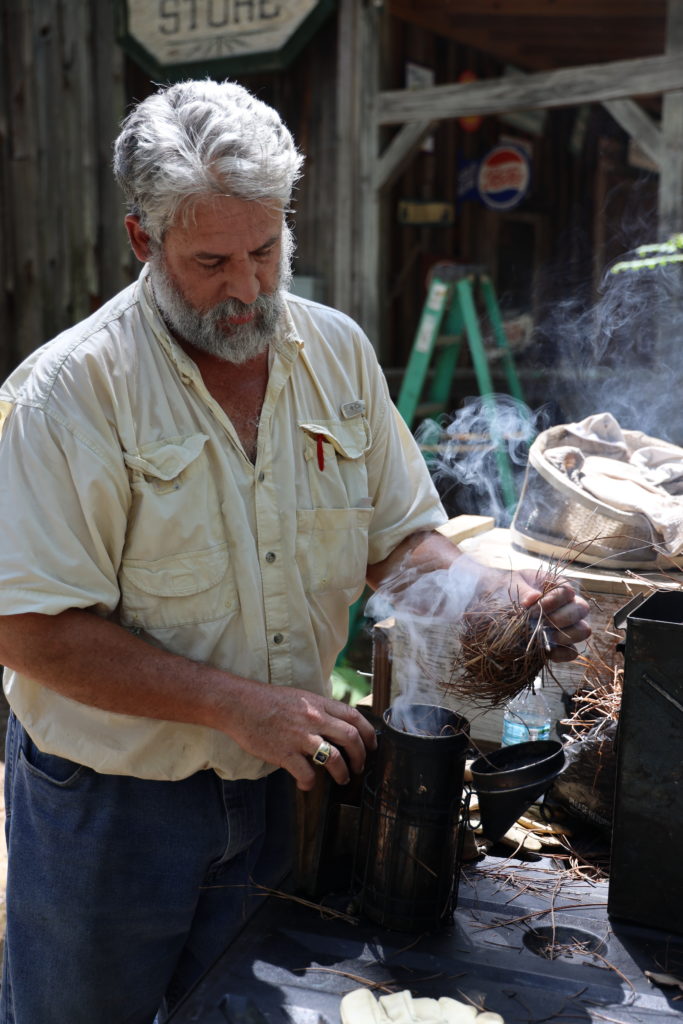The Buzz Around Bee Removal

By Josie Chance
While delicious honey is a sweet nectar of Alabama agriculture, finding a beehive in a wall at home is far from fun.
But Blount County beekeeper Hal Hendrix finds these moments provide a golden opportunity to teach others the importance of pollinators.
“They are responsible for what we eat,” said Hendrix, an Alabama Farmers Federation State Bee & Honey Committee member. “You hear that bees are responsible for pollinating 80% of what we eat, although it honestly ends up being more than that.”
Hendrix often answers this question from curious homeowners: Why did a swarm just show up one day?
A group of bees on the move commonly begins when the colony becomes overpopulated. The bees will decrease food provided to the current queen and prepare a queen brood cell to take her place. Eventually, the older queen takes flight.
“Some of the other bees follow the queen to the next spot, typically a bush, for a while,” said Hendrix, as he laid out tools for a removal at Homestead Hollow, a venue in Springville. “All the scout bees will go out and look for a new home, such as a hole in a wall or tree.”
The Alabama Master Beekeeper said these swarms are docile — and fairly easy to capture.
“Before they leave the hive, they gorge,” he said. “This makes them lethargic, like us after Thanksgiving dinner. They don’t care to bother you, and they have nothing to protect since they have not rebuilt yet.”
When the swarm finds a new location, it immediately begins building comb so the queen can repopulate the hive. This is also where the bees rebuild stores of honey. Hive location determines the need and difficulty of removal. While most beekeepers can easily remove hives from a tree or outdoor area, structural removals require an experienced hand.
“You have to get inside the wall, remove the bees and look for the queen,” he said. “If you can catch her, the other bees will follow.”
Hendrix warned against spraying the bees with an insect suppressant, which causes more damage in the long run.
“You then have to remove all the wax, brood and honey,” he said. “If you leave those without the bees, it will rot, run out and attract insects and rats. It can be detrimental to the building.”
After a hive is located, removing the bees starts with filling a hive smoker, in case it’s needed to calm the bees. The beekeeper puts on a full-coverage bee suit and removes the bees with a special vacuum hose attached to a carpet-padded box. This keeps the bees safe during transport to their new home.
After the external layer of bees is removed, the wall or other barrier is taken down. During the removal at Homestead Hollow, Hendrix removed wooden boards to access a colony.
Next, the bees are contained, and the comb is separated. Honeycomb goes into a container for processing, and the brood comb is banded onto frames.
Finally, repairs return the structure to its normal state. While this appears simple, it can prove expensive, Hendrix said.
“If you are dealing with Sheetrock or brick, it can cost thousands of dollars very quickly,” he said.
Hendrix is quick to offer resources for homeowners seeking a helping hand removing hives.
“Most Alabama Extension offices keep a list of contacts for swarms or structural removals,” he said. “Local bee organizations and associations also have beekeepers to reach out to. If you contact someone in one of those groups, they can get you in touch with someone who can help.”
